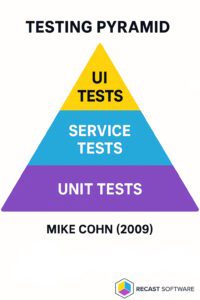Unit Testing Mature Codebases: A Practical Approach
This post will explore Recast’s experience introducing unit tests into an existing application that wasn’t built for testability. Our goal was to improve code quality, reduce regressions, and make future development easier to maintain.
Unit Tests: The Pyramid’s Base
Unit tests form the base of the testing pyramid. They test small, isolated pieces of code (like individual functions or methods). Unit tests are quick to write and fast to run. They mock or stub dependencies—such as databases or APIs—so tests can control the environment and focus on behavior without real external systems.
Their purpose is to catch bugs early, ensure code quality, and prevent regressions.
Developers usually write unit tests alongside new code—often through Test-Driven Development (TDD)—and run them in continuous-integration (CI) pipelines.

How We Rolled Out Testing
Our strategy was to learn by example. Rather than enforcing strict guidelines, we decided that learning through examples and pair programming would be the best approach. This gave engineers unfamiliar with unit testing a chance to practice what they’d picked up from articles, videos, or courses.
Principles We Followed for Unit Testing
- Isolation: Unit tests should avoid external dependencies such as databases or services. When needed, in-memory implementations can be used to simulate these dependencies.
- Behavior Over Implementation: Tests should focus on the behavior of components rather than their interactions. This makes tests more resilient to refactoring.
- Arrange-Act-Assert Pattern: Tests follow three phases—setup (arrange), execution (act), and verification (assert). Bill Wake proposed the pattern in 2001, and Kent Beck popularized it in Test-Driven Development: By Example (2002).
The Hurdles We Faced
- Test Setup Complexity: The existing codebase requires significant setup to make components testable without altering production code.
- Refactoring for Testability: Some code needs refactoring to enable testing, but we try to keep changes minimal to avoid side effects. At first we chose not to touch production code and instead focused on validations and mocked‐database tests.
- Prioritizing What to Test: We asked three questions—Can we test it? How can we test it? What will it cost in effort?—and decided to begin with:
- Starting with Validations: These are easy to isolate and test.
- Mocking the Database: Enables testing of logic that depends on data access.
- Custom REST Layer: A complex but high-impact candidate for future tests.
- Time: Because time is limited, we estimated the effort required for each test area up front.
- Limited Experience: Only one teammate knew unit testing, so the whole team set aside time to learn.
Writing the first tests and training the team took considerable time, but we expect the investment to pay off through fewer bugs and easier maintenance. The team embraced unit testing and management backed the effort, but the real challenge lay in balancing customer demands with ongoing technical improvements.
When AI Helped
After writing the first test cases, we used AI tools to generate more tests in the same format. While not perfect, this approach significantly reduced boilerplate and saved time.
Manual vs. Automated Tests
Manual testing is still essential because test coverage is limited and the codebase changes constantly. However, our long-term vision is to rely more on automated tests (unit, integration, UI) and reduce manual testing to smoke tests.
First Steps for New Testers
- Start with TDD: Learn test-driven development through coding katas and hands-on exercises.
- Use Online Resources: Blogs, videos, and tutorials are valuable for learning best practices.
- Practice in Safe Environments: Experiment with unit testing outside the main codebase to build confidence.
Choosing the Right Tools
Commonly used languages in unit testing include Python, JavaScript, TypeScript, Java, C#, C++, Ruby, Go, and PHP. Each language has mature testing frameworks—like pytest for Python, Jest for JavaScript, JUnit for Java, and xUnit for .NET—that integrate well with CI/CD pipelines, support mocking, and offer test coverage tools.
Ultimately, you should choose the tools and frameworks that best align with your team’s workflows, technology stack, organizational goals, and best practices.
Further Reading
- Dennis Doomen – “What’s the ‘unit’ in unit testing (and why is it not a class?)”
- Martin Fowler – Testing articles hub
- Mike Cohn – “The Forgotten Layer of the Test Automation Pyramid”
- Gerard Meszaros – xUnit Test Patterns (book & companion site)
































